Willkommen: Hier finden Sie die deutsche Version unseres Briefes aus Berlin!Welcome to our Letter from Berlin! This week we continue our weekly film streaming with David Claerbout’s Die Reine Notwendigkeit / The Pure Necessity and also highlight the artist’s recent interviews and lectures. The film is available to view through Sunday night, Berlin time. This Letter from Berlin introduces three recent projects across magazines and the internet: Thomas Demand’s covers for the Italian architecture magazine Domus, Anri Sala’s contribution to M, the magazine of Le Monde, and the enthusiastically received "polite hack" of the website of this year’s Copenhagen Architecture Festival. We also want to draw your attention to an online screening of a work by Hito Steyerl, the Guggenheim Museum’s offer of virtual backgrounds and our new German language Online Viewing Room for Angela Bulloch. Anything you may have missed from our social media channels can be found on Continuity, our digital platform. Read this in good health.
|
|
|
David Claerbout — This weekend's online film screening
|
|

| David Claerbout, Die reine Notwendigkeit/The Pure Necessity, 2016. Color animation, duration 50:00 min.
(This director's cut is 30 minutes long.)
| |
|
This week’s screening is a 30 minutes segment from David Claerbout’s 2016 Die reine Notwendigkeit/The Pure Necessity, his work in reference to Walt Disney’s classic 1967 animated adaptation of Rudyard Kipling's The Jungle Book, reconceived to focus on the daily ennui of the animals.
Claerbout's film follows the tradition of a frame-by-frame animation, re-creating the historical figures: Bagheera the panther, Baloo the bear, Kaa the snake, among others. While the 1967 film portrayed them as anthropomorphized characters, well-known for their witty dialogues, dances and jokes, they are here seen as “realistic” animals. Claerbout represents them wandering in the jungle, drinking from a water spring, sleeping on tree branches, observing one another. Each of their movements is followed with precision and duration, giving the spectator the opportunity to observe every detail of the drawings.
Painstakingly animated—the complete 50 minutes version includes about 90.000 individual drawings—the work deliberately seeks to “decelerate,” constituting a counterpoint to the 1967 classic. That film is characterized by its high-energy song and dance routines, by the constant rhythm and high cheer of feel-good family entertainment. Claerbout has removed the feral child Mowgli and the plot surrounding his re-integration into human society (a conclusion to the film that has struck many a child as counterintuitive, and some adults as a chilling entry into the symbolic order). In addition, we encounter none of the behavior that generally gives a narrative structure to nature documentaries: foraging, playing, or hunting. Their activities are more typical of the caged creatures we encounter in Zoos: bereft of purpose, close to despondency.
While this emphasis on the autonomy from human intervention highlights considerations regarding animals, the artist’s comments about the changing role of watching movies together emphasize another major theme explored by Claerbout’s oeuvre: and the transformation of the communal experience of the moving image into a solitary one. He writes:
In 1967 The Jungle Book appeared in movie theaters, in a time of proliferation of movie theaters and television after the second world war. The cinema became a place where people came to sit down together in silence, side by side, subcontracting the conversation to the screen. After all, many had recently gone through two world wars of which the first was the war to end all wars.
Cinema had become a unifying space. Destruction, the carnivalesque, romance or dance could be replayed ritualistically in a temporal space that was certain to end, and often did end well.
Only now that we watch content on tablets – alone – it becomes possible to appreciate cinema and television as a place for being together, even if that means just sitting side by side in silence.
If what Margaret Thatcher said back in the eighties became true: that there is no society, only individuals and their families, it should be no surprise that by the year 2017 the once energetic characters of Jungle Book are folded back onto themselves in silence. This may reflect back onto the spectator looking at Die reine Notwendigkeit, he or her too, looking in solitude, not in a cinema filled with others.
The choice to work with The Jungle Book was not accidental. The story is that of the strong and potentially cruel helping the weak, until emancipated and ready to face modern life. Around 1967, the individual did not look anything like the individual of today. The individual was a single brick in the architecture of society, today the individual is that society, millions of them.
Over a period of three years, David Claerbout and his team of professional artists redrew the frames of the original movie by hand, one by one, and then assembled them to create an entirely new film—in an important contradiction in terms: a lifeless animation—that stands in raw contrast to the lively and rhythmical precedent.
Decelerating the moving image to counteract its narrative pull that, as the artist has vividly described it, makes adults into kids, staring silently transfixed, lost to the world and lost to their freedom at the screen, Claerbout has taken it upon himself to liberate us from the slavery of constant linear time.
|
|
|
David Claerbout — Recent interviews and lectures
|
|
Produced by Louisiana Channel, the non-profit video channel for the internet launched by the Louisiana Museum of Modern Art, this beautiful documentary was published in April 2020. It features an extensive interview recorded in Antwerp, Belgium in February 2020 (in English).
|
|
|
Podcast from Samstag Museum, Adelaide, Australia. Belgian artist David Claerbout sits down with Rachel Hurst to discuss his monumental moving-image work Olympia (the real-time disintegration into ruins of the Berlin Olympic stadium over the course of a thousand years). Recorded by Denam Moore at the Samstag Museum of Art, Kaurna Adelaide in February 2020 (in English).
|
|
|
Artist talk Galerie Rudolfinum, Prague on the occasion of his opening at the Galerie Rudolfinum, January 29, 2020 (in English).
|
|
|
Conversation with Dr. Martin Engler about Die Reine Notwendigkeit / The Pure Necessity at the Städel Museum in Frankfurt in 2016 (in German).
|
|
|
Anri Sala — Project for M, Le Monde Magazine
|
|
A child, an apple. A bite, an exile. In 2017, in Berlin, the Albanian artist Anri Sala orchestrated a workshop with migrant children. He simply asked them to bite into an apple, a motif that he transformed into musical notes arranged on the scores of different national anthems. „Sketched" by khadija, bahea, samira, laisa, raman or dylar, the notes of "la marseillaise" or "god save the queen" are thus disseminated over the weeks in the pages of “M” [Le Monde Magazine], like a melody bursting out in time and space.
—M, Le Monde Magazine
For twelve weeks M, the Magazine published by French daily newspaper Le Monde on weekends, featured one of Anri Sala’s drawings of apples. Originating from a workshop with refugees he held in Berlin in 2017, each fruit bears a distinct bite mark. For the large-scale work Them Apples, first exhibited in the gallery that year, 44 drawings were placed across the wall as musical notes on an imaginary score of a real musical work: the German national anthem.
The bites, like fingerprints, are unique. An integral part of the project that constitutes the conceptual and material basis for Sala's drawings, was a three-day workshop, organized in cooperation with the public arts organization KurtKurt in Berlin-Moabit. The interaction with the refugees during these sessions in which artist's studio and refugees produced objects, drawings, and photographs, created the conditions from which the drawing project departed-performative, time-based events which became drawings that incorporate this origin.
Anri Sala’s drawings are created through manipulating consecutive layers of
wet ink applied onto stone paper which is characterized by its lack of absorbency-the liquid slowly dries on the surface of the paper. (The process recalls the artist’s early training in fresco painting.)
For his project with Le Monde, Anri Sala chose to expand the scope to other national anthems: those of France, Germany, Italy, the United Kingdom and the United States of America. Each apple again is paired with a note, yet Sala has chosen to include a section of the score and the child’s name below. Apple, note and lyrics thus become more firmly associated with the bitemark’s creator and construct short messages, some apparently uplifting (jour de / gloire, Frei / heit), others more urgent (God / save / Queen!, mor / te). Of course, these would not have manifested for the readers of any single issue of the magazine. Apart from the larger political context invoked by the five anthems chosen by the artist, there is also a simple analogy we may take from this: as notes make music and words language, the fates of individual children are a humanitarian crisis.
|
|
|
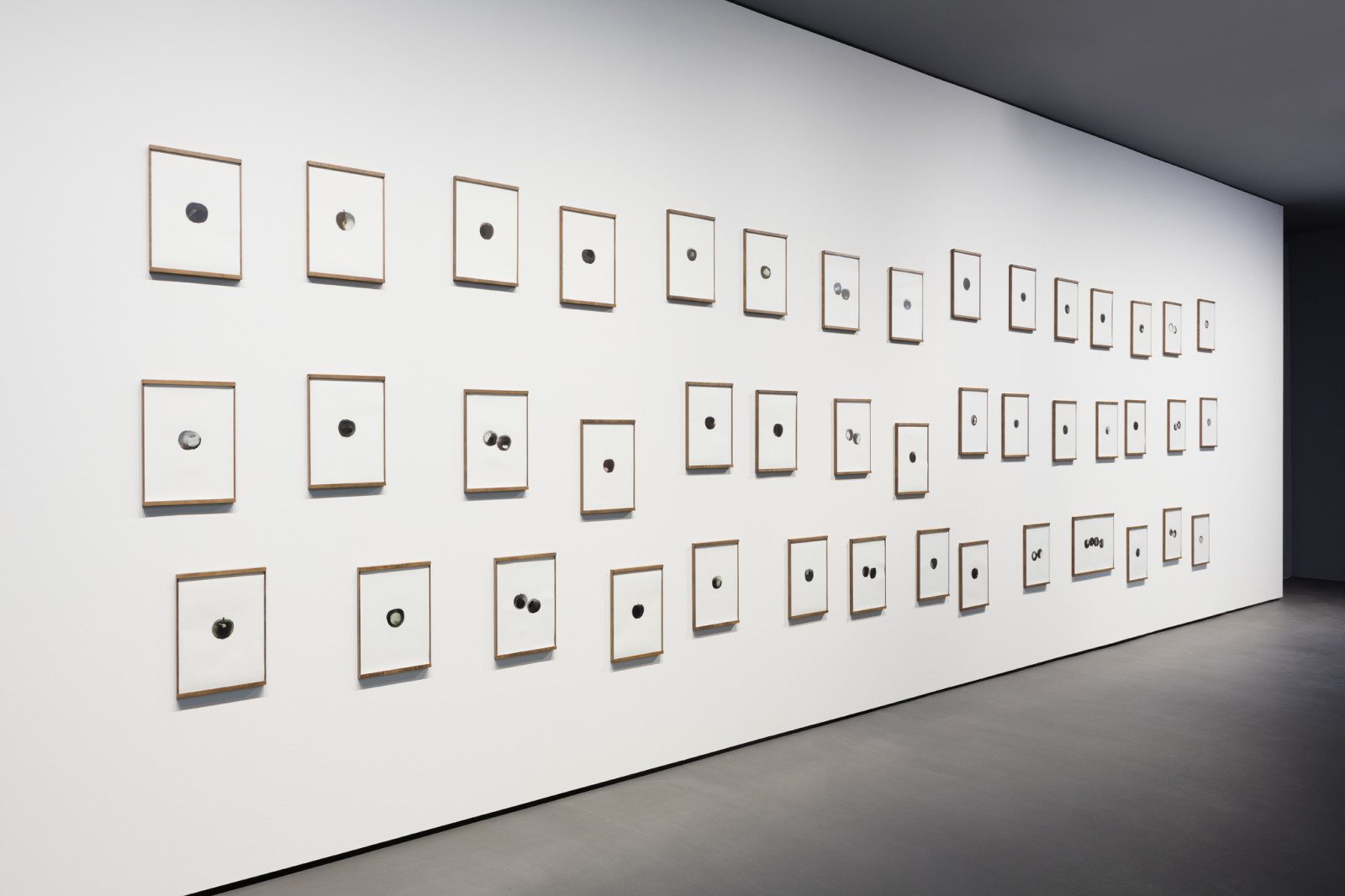 | Anri Sala, Them Apples, 2017, ink on stone paper, 44 parts, 42 x 29,7 cm each (43 parts), 42 x 59,4 cm (1 part)
Exhibition view: Anri Sala, Take Over, Esther Schipper, Berlin, 2017
© VG Bild-Kunst, Bonn, 2020. Photo © Andrea Rossetti
| |
|
Thomas Demand — Project for Domus Magazine
|
|
Thomas Demand and Domus: "The front of a magazine is itself a kind of facade"
The Italian magazine Domus has long been a major force of architectural publishing. Founded by Gio Ponti in 1928, the magazine began planning for its 100 years anniversary already two years ago with an ambitious program of a decade of yearly guest editors. In 2020 the British architect David Chipperfield took on this function. Known in Berlin for his thoughtful reconstruction of the Neues Museum (1993-2009) and the more recent completion of the James-Simon-Galerie (1999-2018), Chipperfield collaborated with Thomas Demand who will make all the magazine’s 10 covers this year. The fifth is about to be published.
The series depicts architecture which got into trouble, as Demand puts it. These are designs which became symbolic architectural forms for current disputes without necessarily being built with any such intention.
January
Gio Ponti, Concattedrale Gran Madre di Dio, Taranto
Seen head-on from the outside, Gio Ponti's Concattedrale Gran Madre di Dio's façade and bell tower appear linear, with little depth, similar to a cutout of a model. Apparently inspired by the idea of a sail, Ponti took into consideration the cathedral’s maritime location in Taranto, site of a major naval base in southern Italy, while the pointed openings in its lattice walls also recall the formal vocabulary of gothic architecture.
February
Paul Revere Williams, Shepard lvory Franz Hall II, Los Angeles
The 1967 building on the Los Angeles campus of the University of California was designed by Paul Revere Williams who, despite having built hundreds of structures across Los Angeles, is today perhaps best known for being the first African-American member of the American Institute of Architects. This is the first time his work has been featured on the cover of Domus.
March
Border wall
The March cover refers to a prototype for the US-Mexican border wall advocated by Donald Trump. In October 2017, eight prototype sections were unveiled, among them one produced by Elta North America, a defense manufacturer owned by Israel Aerospace lndustries.
April
Diamond Princess
The Diamond Princess cruise ship gained notoriety when in early February 2020 several passengers were diagnosed with the novel coronavirus and Japanese health officials imposed a mandatory 14-day quarantine on the vessel which was then anchored in Yokohama, Japan. Aboard the ship were a total of 2,666 passengers and 1045 crew members whose daily activities were reported in worldwide news.
May
Victor Bisharat, Purdue Pharma Building, Stamford
Originally built as the headquarters of G.T.E (General Telephone and Electronics Corporation) in Stamford, Connecticut in 1973, the structure, designed by Victor Bisharat, was bought in 1999 by Purdue Pharma, a company currently facing intense criticism and legal action for its marketing and sale practices of the opioid Oxycontin.
|
|
|
space-time.tv — Copenhagen Architecture Festival / cafx.dk
|
|
The website of the COPENHAGEN ARCHITECTURE FESTIVAL which had been scheduled to take place from April 23 through May 3, 2020 has been hacked. In fact, it keeps getting hacked each week with new content. Sounding a note of surprising enthusiasm, the hacked have cheerfully announced their calamity on e-flux architecture three weeks ago:
Since last week we’ve been hacked by TV and as of today the selection of flicks screened on our website has already changed. The very polite hackers who described their "ideology" as "anti-philantro-tech-capitalist" have come up with more "alternative storytelling." From Quincy, Manheim, Preston, Tarnac, and Qattara. This week, they want to "Politicize the Countryside" and "De-Romanticize the Countryside."
Since then the hackers have almost completely taken over: when you visit the CAFX website, the distinct voice of space-time.tv greats you. The collaborative project which Christopher Roth, its self-described “broadcast operator and concierge”, presented in the gallery’s bookstore space last summer, has been operating three online TV channels with largely self-generated content and found footage since 2018. Soon a new channel will be added, connected to 2038, another ambitious collaborative initiative set to premiere at the Venice Architecture Biennial, now scheduled to open in late August. |
|
|
 | Screen shot of the hacked Copenhagen Architecture Festival website, www.casfx.dk
| |
|
Christopher Roth, whose practice may be best understood as a kind of proactive intellectual scholarship that combines the factual and fictitious, with both analytic and poetic qualities, has since the 1990s, focused on the “emptiness” of single images and certain generic imagery that surround us. These images only accrue meaning in context—a function easily manipulated by the mass media. This knowledge — acquired and practiced as an accomplished film editor and director of feature films, and given theoretical underpinnings by his engagement with cultural history and philosophy—informs his new projects as well.
Seeking to understand how information, words, pictures and ideas are received, travel and are mediated at a constantly accelerating pace, in recent years Roth has undertaken to renew tv’s early promise by reconceptualizing it for the digital, online moment.
He writes:
Television was always very close to the real world. At its best it was about what is and then concluded what could be. The responsibility was not only to show the present but to imagine the future and furthermore to imagine how we might change its direction. Television was and is a utopian concept. Television gathers data, makes polls, establishes facts and analyses them, but only when it creates stories and fiction it establishes values. It becomes political. That’s why it’s so important by whom these stories are told.
There is a radical positivist quality to all this: not in reference to the empiricist bias of the philosophical bent—although a certain “what you see is what you see” is certainly part of the appeal of this fast-paced visual culture—but also in the sense of being positive about the present and the future. To quote space-time.tv’s Eight Rules for TV:
We don’t believe in the lonely genius. Neither in resistance, withdrawal or anarchy.
We believe in (science) fiction, the realism of our time. The future is neither a nightmare nor a daydream.
We speculate even as we try to minimize uncertainties. We try to come up with stories, answers and possibilities, not with mere observations.
We try to make complex ideas seem simple. Build arguments, form positions, create a tagline, be populist.
We believe in compression. If arguments don’t survive compression, they are bad. No piece should be longer than five minutes. Better two.
We are not going to talk about everything to absolutely everyone. We will leave that to contemporary art and architecture.
We make programs with recurring episodes, not unique masterpieces.
We try to think politically about the relations between subjects, whether human or nonhuman.
Stop looking at yourself. Look around you. Interesting things are always close by.
|
|
|
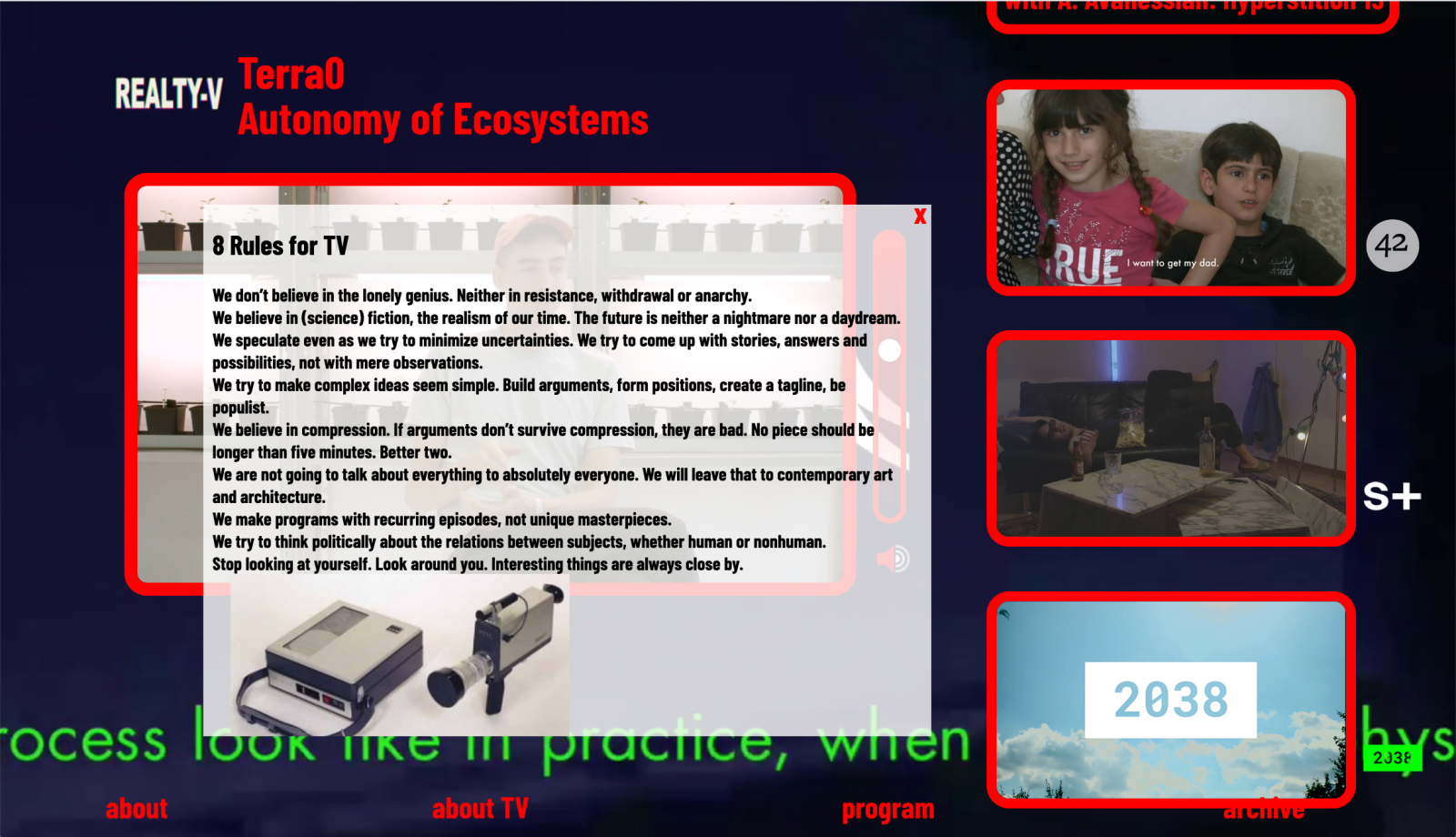
| Screen shot space-time.tv with its Eight Rules for TV.
| |
|
This utopianism which bills itself as realism is very much in evidence in the 2038 project as well. As the statement of its initiators, written in 2038, stipulates:
Today, in the year 2038, we have mastered the great crises. It was close, but we made it. The global ecological, social and economic disasters of the 2020s brought people, states, institutions and companies together. They committed themselves to fundamental rights and jointly created viable, adaptable systems and legal frameworks on a planetary basis, giving decentralised, local structures the space to maintain and create highly diverse models of co-existing.
Technology and big data helped us to turn new and old ideas into reality. And often architects were part of the solution because they had answers instead of coming up with more questions. Drama is now history. We live in a radical democracy, in a radical bureaucracy. On a planet that doesn't know or need heroes or villains.
It just needs more tv, more space-time.tv.
|
|
|
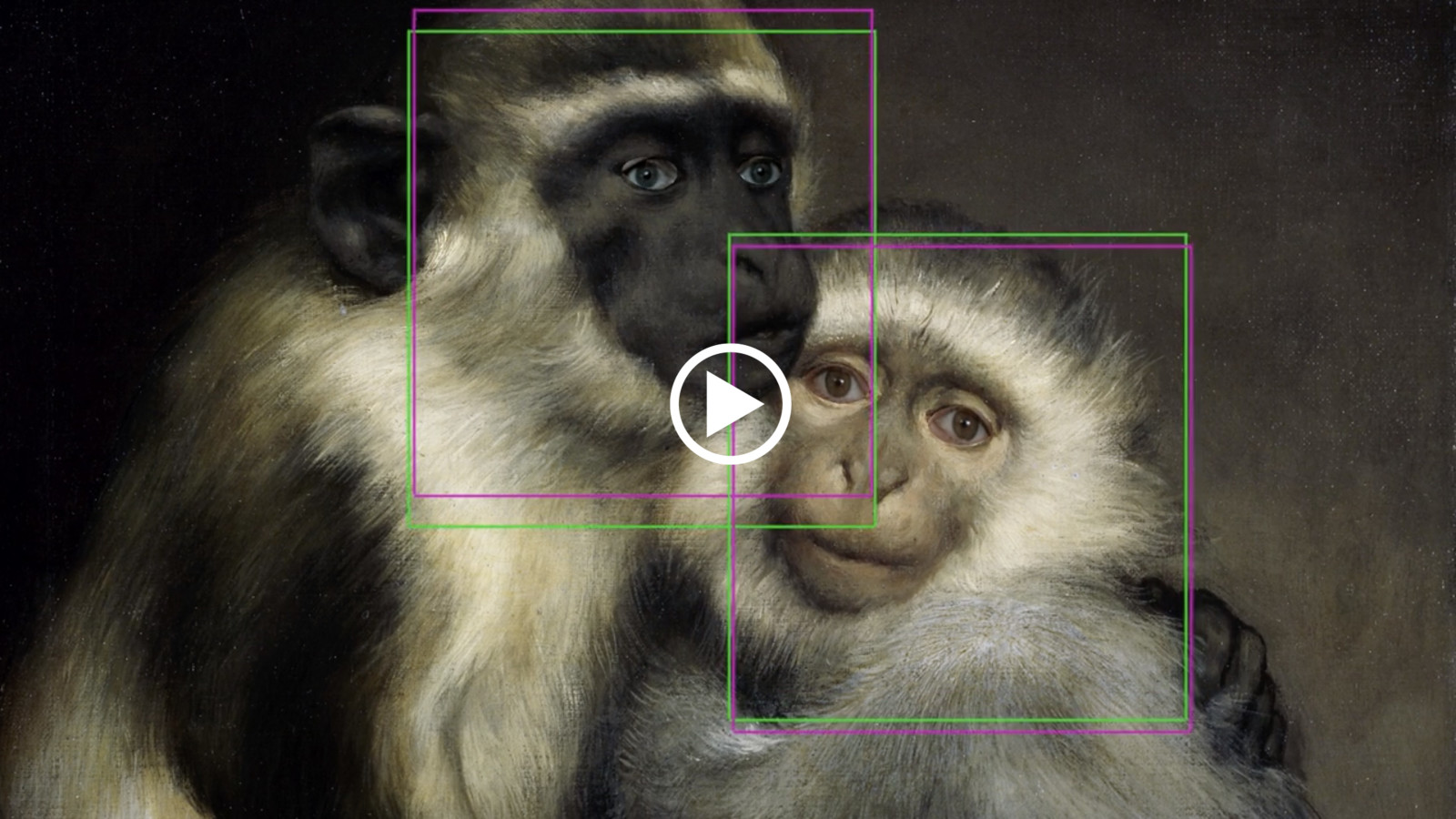
| The New Serenity 2038. (link to the project's website and trailer)
| |
|
Angela Bulloch Online Viewing Room — now in German!
|
|
We are happy to announce the launch of our German language Online Viewing Room dedicated to Angela Bulloch’s 30 years history with the gallery. |
|
|
The Reading Corner – A Selection of Publications |
|
Anri Sala
As You Go
Publisher: Skira, 2020
Language: English, Italian
Available here
|
|
|
Thomas Demand
The Complete Papers
Publisher: Mack, 2018
Language: English
Available here
|
|
|
David Claerbout
Drawings and Studies
Publisher: Hatje Cantz, 2015
Language: English
Available here
|
|
|
Georg Diez / Christopher Roth
What Happened? 80*81
Publisher: Merve Verlag, 2016
Language: English
Available here
|
|
|
The Work of Hito Steyerl — n.b.k online video streaming
|
|
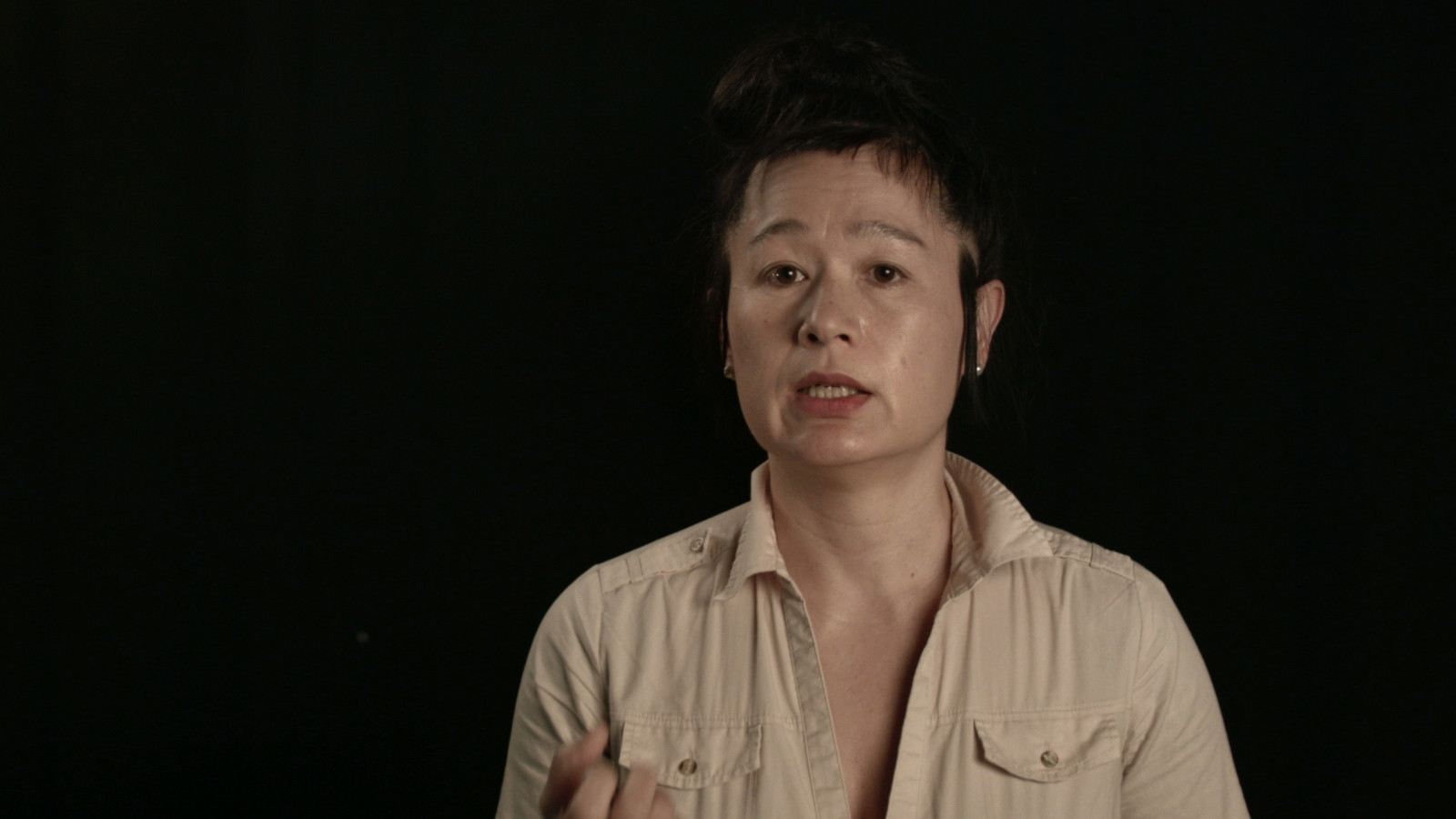
| Hito Steyerl, Duty Free Art, 2015, HD video with sound, duration: 38:21 min.
© VG Bild-Kunst, Bonn, 2020. Film still © Hito Steyerl | |
|
We want to draw your attention to the online streaming of Hito Steyerl’s 2015 Duty Free Art as part of the n.b.k. Video-Forum 2019. This year, n.b.k. presents a selection of the newly acquired video works for the collection of the n.b.k. Video-Forum in two online screenings on its website – part II is now online until May 24 and can be watched on www.nbk.org.
Screening II
Monday, May 4, until Sunday, May 24, 2020
With video works by Candice Breitz, Lia Perjovschi, Tomas Schmit, Hito Steyerl
This screening features the rarely shown works The Magic of Gestures (Laces) (1989) by Lia Perjovschi, the work e-constellations (2004) by Tomas Schmit, Factum Misericordia (2009) from the series Factum by Candice Breitz, and Hito Steyerl’s lecture Duty Free Art (2015).
|
|
|
Virtual backgrounds from the Guggenheim Museum
|
|
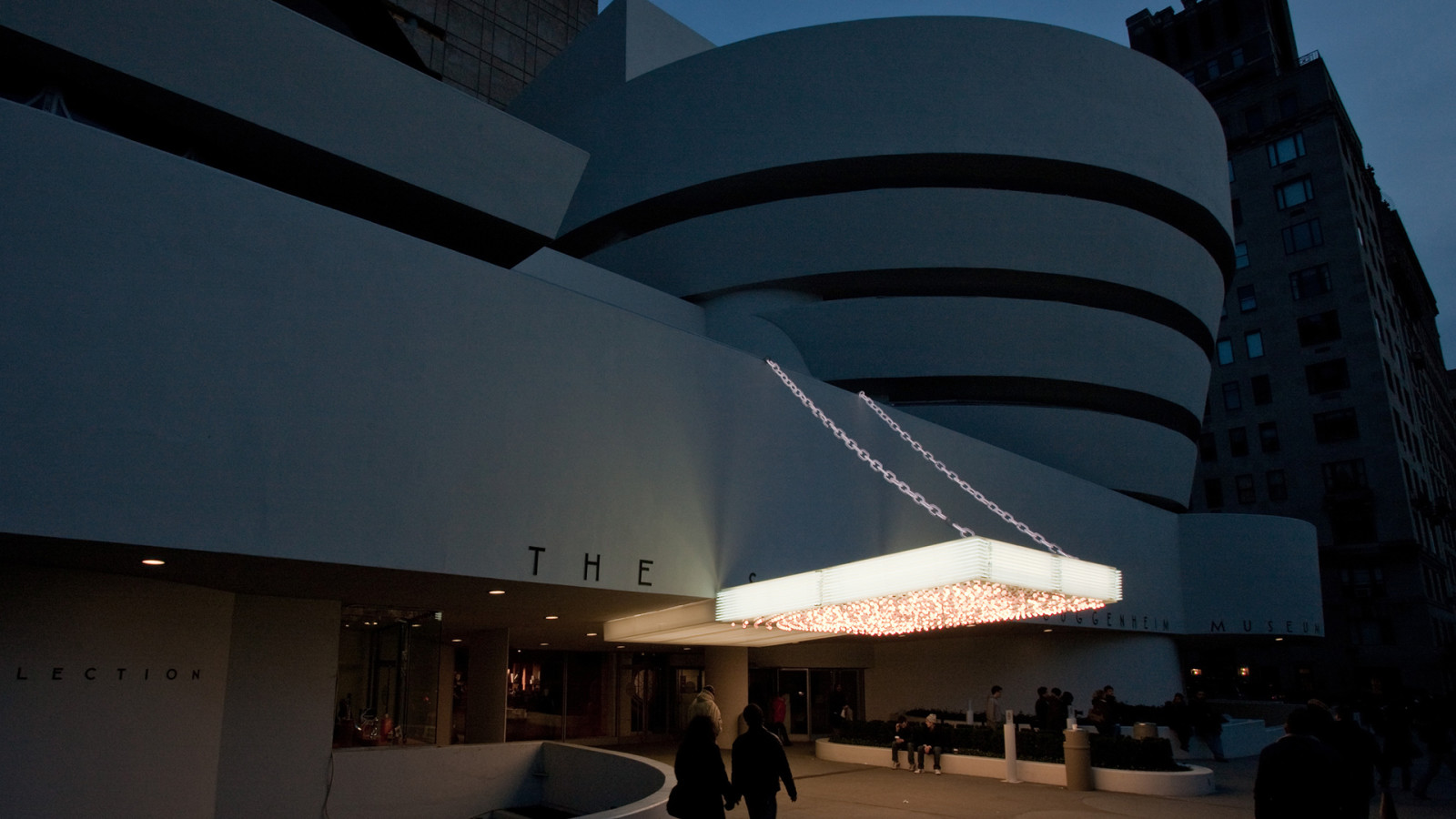 | Philippe Parreno, Marquee, 2008. Exhibition view: theanyspacewhatever, Solomon R. Guggenheim Museum, New York, 2008. Photo © David Heald | |
|
Zoom with a View!
Transport Yourself to the Guggenheim with Free Virtual Backgrounds
The Guggenheim Museum is providing installation views from major exhibitions to be used as virtual backgrounds for Zoom and other video chat platforms. The images are available for download on the museum’s website.
Choose among iconic exhibition views, among them of Angela Bulloch’s Firmamental Night Sky: Oculus.12 (2008), a work from her series of “night skies” which the artist placed in the ceiling of the Guggenheim’s rotunda, and of Philippe Parreno’s Marquee, a large-scale illuminated canopy installed above the entrance on the building’s façade, both from the landmark group exhibition theanyspacewhatever in 2008. |
|
|
Under the heading Messages from Home artists are sending videos from their (temporary) studios or homes. This time Tao Hui shares a recipe of his take on a Chinese-style ice plant salad! |
|
|
Journey Through the Gallery |
|
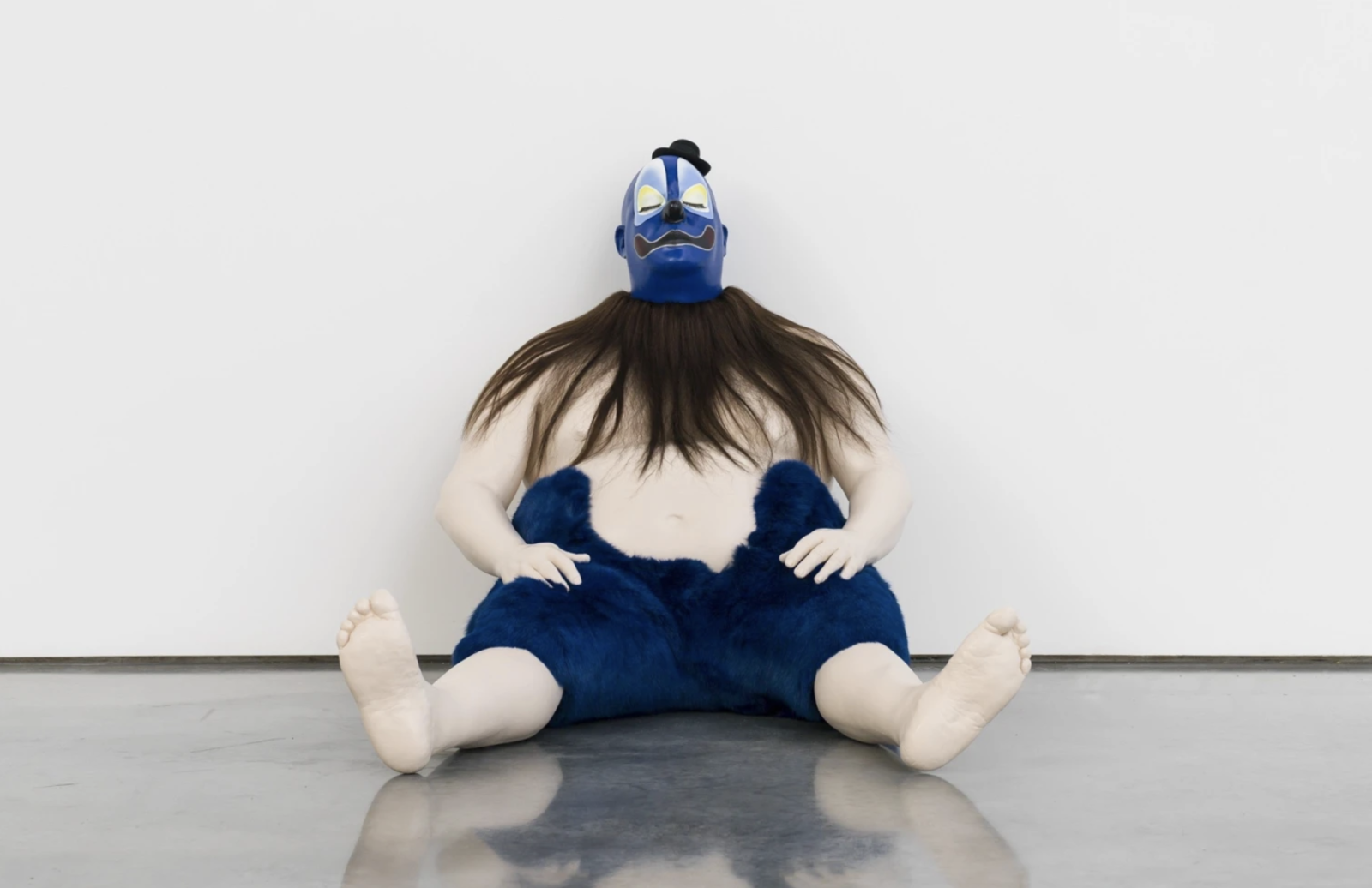
| Exhibition view: Ugo Rondinone, Slow Graffiti, Schipper & Krome, Berlin, 2001
Photo © Studio Rondinone⠀ | |
|
Ugo Rondinone's 2001 exhibition "Slow Graffiti" consisted of two new works. The exhibition space was dominated by a tessellated mirror partition (5 x 5 meters) which is positioned in a way to reflect the whole room in fragments, or rather to display a distorted picture of the room in which the sculpture, a clown figure made of polyester, leans passively against the wall. Integrated into the partition there were four loudspeakers playing a dialogue typical of Rondinone. To be heard is a woman's voice from the left and a man's voice from the right channel. The Beckett-like one-minute dialogue of the two voices talking at cross-purposes, fitted together to make a loop, expresses a depressing purposelessness, regarding content as well as formal aspects. The confrontation of these two sculptures, unavoidably combined with the distorted reflection of the beholder, results in an atmosphere of neutralisation of activity, stirred only by the tessellated reflection bringing motion or activity into the picture. The cardinal role of the clown, to evoke liveliness, fun and activity, briefly, to entertain, is passé. Whagged, haggard. Questions about heteronomy and self-determination, about strict delimitation and outlined identity press for answers. See inside the exhibition here
|
|
|
|
|